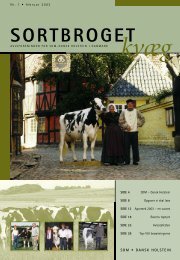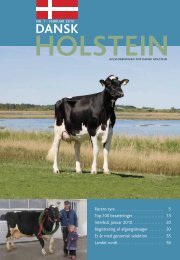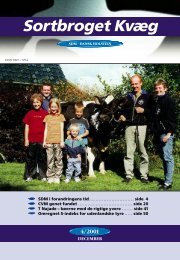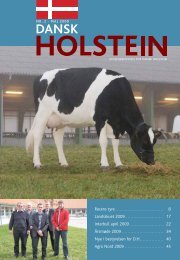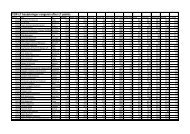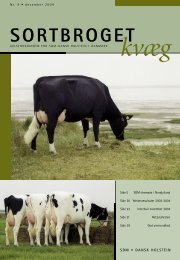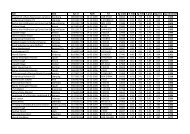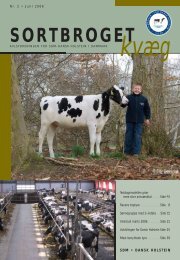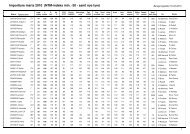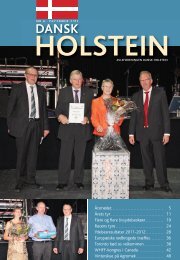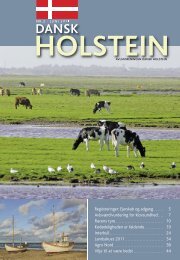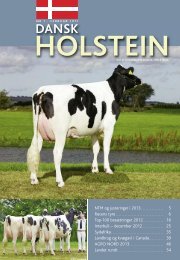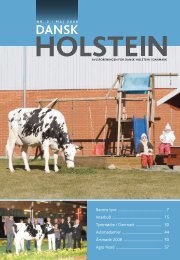2012 WORLD HOLSTEIN CONFERENCE - Dansk Holstein
2012 WORLD HOLSTEIN CONFERENCE - Dansk Holstein
2012 WORLD HOLSTEIN CONFERENCE - Dansk Holstein
Create successful ePaper yourself
Turn your PDF publications into a flip-book with our unique Google optimized e-Paper software.
contents<strong>2012</strong><strong>WORLD</strong> <strong>HOLSTEIN</strong><strong>CONFERENCE</strong>INTRODUCTION FROM WHFF PRESIDENTINTRODUCTION FROM<strong>2012</strong> <strong>WORLD</strong> <strong>HOLSTEIN</strong> <strong>CONFERENCE</strong> CO-CHAIRS<strong>WORLD</strong> <strong>CONFERENCE</strong> SCHEDULE<strong>WORLD</strong> SYMPOSIUM AGENDASession 1: The Genomics Revolutions091011Session 2: Impact of Genomics on the Industry131415Session 3: Improving Reproduction Using New Technologies171819Session 4: Improving Our Cow’s Health & Welfare212223Session 5: Ensuring Farm Sustainability252627Session 6: Getting More Out of Milk293031Didier BoichardBen HayesFlavio SchenkelJosef PottMarjorie FaustSander de RoosKen NordlundSven KönigClaire PonsartGerard CramerMichael CollinsGert Pedersen AamandPaul BoettcherLucy Andrews-NodenElaine FroeseNeil PetrenyNicolas GenglerTove Asmussen2
<strong>CONFERENCE</strong> SCHEDULE & OVERVIEWPRE-<strong>CONFERENCE</strong> -- MONTREALFriday, November 2nd, <strong>2012</strong>07:30 - 16:00 Pierre Elliott Trudeau Tour: “Astonic, Gen-Com, CIAQ, La Presentation”08:00 - 16:00 Bus to Quebec International Red & White Show, St-Hyacinthe16:00 - 18:30 Buffet dinner and Embryo sale19:00 - 21:00 Welcome Reception, Genomic Power Sale, St-HyacintheSaturday, November 3rd, <strong>2012</strong>08:00 - 16:00 Bus to Quebec International Black & White Show, St-Hyacinthe08:00 - 13:00 Montreal City Tour17:00 - 19:00 Grand Champion Buffet, St-HyacintheSunday, November 4th, <strong>2012</strong>07:00 - 18:00 Sir John A. Macdonald Tour: “Gillette, Ottawa, EastGen, Toronto”MAIN <strong>CONFERENCE</strong> -- TORONTOSunday, November 4th, <strong>2012</strong>19:00T.O. Surprise Dinner18:00 - 22:00 WHFF Council, <strong>Holstein</strong> Canada Board, Youth Dinner at CN TowerMonday, November 5th, <strong>2012</strong>07:30 - 16:30 Wayne Gretzky Tour: “Summitholm, Mapel Wood, TSC Store”07:30 - 16:30 Terry Fox Tour: “J&L Walker, Maple Keys, GayLea Dairy Heritage Museum”07:30 - 16:30 Shania Twain Tour: “Fafard Sculptures, Stantons, Wikkerink”08:00 - 16:30 David Suzuki Tour: “Bosdale, Claynook, Cityview, Springbank Show Countess”08:00 - 16:00 Alexander Graham Bell Tour: “Armstrong Manor, Altona Lea, Quality”07:30 - 16:00 Sidney Crosby Tour (Young Adult Convention): “Cranston, Summitholm, Bosdale”20:00 - 22:00 Multi-cultural Social Soir”eh”Tuesday, November 6th, <strong>2012</strong>08:30 - 16:00 Toronto City Tour08:00 - 17:00 World Symposium18:00 - 22:00 Northern Lights & Winter Nights GalaWednesday, November 7th, <strong>2012</strong>08:00 - 12:00 World Symposium13:30 - 17:00 WHFF General Assembly19:00 - 21:00 International ReceptionPOST-<strong>CONFERENCE</strong> -- TORONTO / NIAGARA FALLSThursday, November 8th, <strong>2012</strong>07:30 - 18:30 Niagara Falls Tour09:00 - 17:00 Royal Agricultural Winter Fair Red & White <strong>Holstein</strong> Show18:30 - 21:00 Sale of StarsFriday, November 9th, <strong>2012</strong>07:30 - 19:30 Royal Agricultural Winter Fair Black & White Show5
<strong>WORLD</strong> <strong>HOLSTEIN</strong> <strong>CONFERENCE</strong> SYMPOSIUMTUESDAY, NOVEMBER 6TH, <strong>2012</strong>TIME TOPIC SPEAKER8:00 A.M. OPENING & WORDS OF WELCOMEIntroduction to Symposium ThemeDairying in Canada: The Quest for EfficienciesEgbert Feddersen, Chair WHFFBrian Leach and Pascal Lemire,Co-ChairsGlen McNeil, President,<strong>Holstein</strong> CanadaSession 108:3009:0009:3010:00Session 210:3011:0011:3012:00 - 13:30THE GENOMICS REVOLUTIONSGenomic Developments - Past, Present and FutureWhat’s Coming Next in GenomicsInbreeding Using Genomicas & How it Can HelpCoffee BreakIMPACT OF GENOMICS ON THE INDUSTRYHow Genomics is Changing the Business and Services of AssociationsSelection and Application – Making More Profitable <strong>Holstein</strong>sReliable Genomic Evaluations Across Breeds and BordersLunchChair: Ann Louise CarsonDidier Boichard (FRANCE)Ben Hayes (AUSTRALIA)Flavio Schenkel (CANADA)Chair: Egbert FeddersenJosef Pott (GERMANY)Majorie Faust (USA)Sander de Roos (NETHERLANDS)Session 313:3014:0014:3015:00IMPROVING REPRODUCTION USING NEW TECHNOLOGIESTransition Cow Index TM (TCI TM )Potential Market Value of Reproductive TechnologiesAdvancement in Natural Heat DetectionCoffee BreakChair: Jos BuitingKen Nordlund (USA)Sven König (GERMANY)Claire Ponsart (FRANCE)Session 415:3016:0016:3017:00EveningIMPROVING OUR COW’S HEALTH & WELFAREThe Role of Genetics in a Foot Health ProgramCombating Johne’s disease using Management & GeneticsSelection for Disease ResistanceConference adjournsWorld <strong>Holstein</strong>-Friesian Federation GalaChair: John MeyerGerard Cramer (CANADA)Michael Collins (USA)Gert Pedersen Aamand (DENMARK)6
<strong>WORLD</strong> <strong>HOLSTEIN</strong> <strong>CONFERENCE</strong> SYMPOSIUMWEDNESDAY, NOVEMBER 7TH, <strong>2012</strong>TIME TOPIC SPEAKERSession 508:3009:0009:3010:00Session 610:3011:0011:3012:0012:10- 13:3013:30 - 17:00ENSURING FARM SUSTAINABILITYEnvironmental-Friendly Cows – Reducing our Environmental Hoof PrintRule of Breed Societies in Sustaining the Industry for Future GenerationsWhat Dairy’s Next Generation Needs for Succession SuccessCoffee BreakGETTING MORE OUT OF MILKUsing milk to test for health & reproductive statusCapitalizing on mid-infrared to improve nutritional and environmentalquality of milkUsing Milk Analyses to Improve Herd Management: New opportunitieson-farm as well as in-lab emerge continuouslyWrap-upLunchWHFF General AssemblyChair: Matthew ShafferPaul Boettcher (FAO)Lucy Andrews-Noden (UK)Elaine Froese (CANADA)Chair: Liliana ChazoNeil Petreny (CANADA)Nicolas Gengler (BELGIUM)Tove Asmussen (DENMARK)Sponsored by7
contentssession 1The GenomicsRevolution8
SESSION 1: THE GENOMIC REVOLUTIONGenomic Developments—Past, Present, and FutureDIDIER BOICHARD (FRANCE)Didier Boichard graduated from the Agricultural University of Parisand made his PhD focus on fertility of dairy cattle. He joined theFrench National Institute for Agricultural Research (INRA) in 1982and made his main research contributions in dairy cattle geneticsand breeding, particularly on the analysis of genetic variability ofproduction and functional traits. He was in charge of the Frenchnational genetic evaluation for dairy cattle, sheep and goat. Heconducted several projects for QTL detection and fine mapping,within breed as well as in crossbreeding. In 2002, in close collaborationwith the French breeding industry, Didier implemented a large scalemarker-assisted selection program, which transformed in 2008, intoa genomic selection program. From 2002 to 2009, he headed theAnimal Genetics Division of INRA. He is presently leading the Cattle Genetics and Genomics group at INRA.He is author or co-author of 70 peer-reviewed papers and is Editor-in-chief of the journal Genetics SelectionEvolution.Within breed genomic selection has been successfully implemented in dairy cattle, taking advantage of very favorableconditions: good genomic resources and tools, large reference populations (RP), high profitability… Recentdevelopments include enlargements of RP within international consortia; use of low-density chips and imputationto decrease costs; large scale implementation in breeding schemes as well as on farm. However, further developmentsare needed for enhanced benefits. Linkage disequilibrium between markers and genes of interest must be increasedthrough higher markers density, by using haplotype information (as presently in the French evaluation system), andthrough discovery and use of causative mutations. The efficiency of current evaluation systems is too dependent onthe relationship between candidates and the RP. Future evaluations should be more robust to this in order to avoidrecurrent update of the RP and accurately evaluate original animals. Taking advantage of across breeds informationwill be crucial even in <strong>Holstein</strong> for some traits difficult to record such as feed efficiency. Such an across breedevaluation will rely on high density genotypes and whole genome resequencing of an increasing number of animals.Another main challenge is the inclusion of new traits in breeding objectives. Obtaining relevant phenotypes willdepend on our capacity to collect precise information, from a technical viewpoint and with the appropriate economicmodel. Primary target traits are fatty acid milk composition through MIR data and health traits. For most of thesenew traits, the RP will be composed of genotyped cows with individual performances.09
SESSION 1: THE GENOMIC REVOLUTIONWhat’s Coming Next in GenomicsBEN HAYS (AUSTRALIA)Dr. Ben Hayes has a wide ranging career designing geneticimprovement programs for beef cattle, sheep and Atlantic salmon.However, his focus for the past five years has been the development ofgenomic selection methods, particularly for dairy cattle. Recent workhas addressed the challenges of optimal breeding program designwith genomic selection, incorporating whole genome sequenceinformation into genomic selection in the 1000 bull genomes project,as well as improving feed conversion of dairy cattle. Dr. Hayescurrently leads the dairy cattle genetics program in the Dairy FuturesCooperative Research Centre.Genomic breeding values are now widely used for selection of bulls, and heifers, in dairy industries around the world.The are three major challenges for the future 1) improving the reliability of genomic breeding values 2) reducing thecost of genomic breeding values and 3) expanding the list of traits for which genomic breeding values are available for,to include traits which are likely to be important in the future such as feed conversion efficiency and methane emissionlevels.The first challenge could be met by both increasing the size of the reference populations used to estimate DNA varianteffects (eg more bulls and cows genotyped with excellent records), and moving from DNA markers (eg SNP chips) to fullgenome sequence. Unfortunately the cost of sequencing is such that it is unlikely that the entire reference populationwill be sequenced. An alternative strategy is to sequence key ancestor bulls of the current <strong>Holstein</strong> populations (usuallythe “legends” of the breed), then impute the genotypes for the sequence variants into much larger reference sets withphenotypes and SNP chip genotypes. The 1000 Bull Genomes Project is an international project with precisely this aim.If the cost of obtaining genomic breeding values (including DNA marker genotyping) could be significantly reduced,they could be more widely used to select heifer replacements. This would have the great advantage that hundredsof thousands of genotyped heifers would eventually become part of the reference population, which would in turnimprove the reliability of the genomic breeding values. New technologies to reduce cost of genomic breeding valuesare discussed.Finally, genomic breeding values offer the opportunity to select for traits which contribute to profit, but would otherwisebe prohibitively expensive to measure. Feed conversion efficiency (eg the efficiency of turning feed into milk) is anexcellent example. Australian and international progress toward feed conversion efficiency genomic breeding valuesare described.10
SESSION 1: THE GENOMIC REVOLUTIONInbreeding Using Genomics & How It Can HelpFLAVIO SCHENKEL (CANADA)Dr. Schenkel holds a number of degrees including a Ph.D. in AnimalBreeding from the Department of Animal and Poultry Science,University of Guelph. He also holds a B.Sc. and M.Sc. from FederalUniversity of Rio Grande do Sul, Brazil. In his academic activities,Dr. Schenkel has published 51 refereed papers, 57 short papers inconferences, and more than 98 scientific abstracts and technicalarticles. His main academic interests are in the genetic improvementof livestock including estimation of genetic and environmentalparameters required for genetic evaluations; genetic evaluation andimprovement of livestock through statistical modeling; detection ofquantitative trait loci; combining molecular and quantitative geneticinformation into genetic evaluations; genomically enhanced geneticevaluations and selection; and conservation of genetic variability and diversity.Inbreeding is a current topic in <strong>Holstein</strong> breeding mainly because breeding programs around the world arefocussed on a limited number of <strong>Holstein</strong> bulls to be used as sires of sons. Genomic selection has been successfullyimplemented in <strong>Holstein</strong> cattle evaluation in several countries worldwide. One of the challenges that still remainsafter its implementation is how to optimally manage inbreeding. Studies suggest that genomic selection will resultin a lower rate of inbreeding per generation, a consequence of increasing selection emphasis on Mendelian samplingcomponent of the breeding value rather than on the part derived from relatives. This allows differentiate full-sibsthat have different Mendelian sampling values, therefore being less likely to co-select them for breeding than if theselection decision was made just based on their parents’ breeding values. Nevertheless, because genomic evaluation isavailable early in the animal’s life, the corresponding decrease in generation interval might actually result in an increasein inbreeding per year. Genomic information offers, however, an excellent opportunity to examine inbreeding andgenetic diversity at the genome level, so that the actual levels of inbreeding and relationship between individualscan be more accurately calculated and predicted. Simulation studies show that selection schemes (e.g., optimumcontribution) and mating strategies (e.g., minimum co-ancestry) might be even more valuable to control inbreedingunder genomic selection than before. The development of strategies to better use genomic information aiming tomake fast genetic progress whilst managing inbreeding and diversity levels seems currently needed.11
SESSION 3: IMPROVING REPRODUCTIONUSING NEW TECHNOLOGIESTransition Cow Index TM (TCI TM )KEN NORDLUND (USA)Ken Nordlund is a Clinical Professor in the Food Animal ProductionMedicine group in the School of Veterinary Medicine at the Universityof Wisconsin-Madison. He received his veterinary degree from theUniversity of Minnesota in 1977 and was a private practitioner andpractice owner in Fergus Falls, Minnesota from 1977 to 1989. He is aboard-certified Dairy Specialist in the American Board of VeterinaryPractitioners. In 1989, he joined the University of Wisconsin andhelped to found the Food Animal Production Medicine program.His research interests include dairy record systems includingdevelopment of the Transition Cow Index TM and interactions betweendairy cattle housing and health.Approximately 75% of dairy cow disease events occur in the month during the transition period of 3 weeks beforethrough the month after calving. Because these disease events early during the lactation have a huge impact onfuture survival and milk yield, a system to objectively evaluate and monitor management of the transition period isimportant for improving dairy herd productivity. On-farm records of disease events are too variable between farmsfor this purpose. A method called Transition Cow Index TM has been developed where the actual 1st test milk yieldcollected between 5-40 DIM is compared to a prediction of 1st test milk yield. The prediction equations weredeveloped using mixed models and the AgSource DHIA cow data from a two-year period representing 4,025 herdsand approximately a half-million cows.Studies have shown TCI TM to be negatively associated with fresh cow disease events. Using a stratified randomselection of Wisconsin freestall herds, transition management practices and facilities were evaluated in 50 herds thataveraged 699 cows in size. Herd average TCI® scores ranged from -4,404 to +2,413 lbs. Risk factors associated withherd average TCI scores were prefresh bunk space per cow, freestall base, size of freestalls, days in calving pens, anddisease screening methods.TCI TM offers a method to benchmark individual herd transition management programs, provides economicinformation about the value of programs, and offers a tool for ongoing monitoring of herd transition managementprograms.17
SESSION 3: IMPROVING REPRODUCTIONUSING NEW TECHNOLOGIESPotential Market Value of Reproductive TechnologiesSVEN KÖNIG (GERMANY)Doctor Sven König is a Professor of Animal Breeding at the Universityof Kassel in Kassel, Germany. While completing his PhD at theInstitute of Animal Breeding and Genetics, University of Göttingen,he was an employee at the dairy cattle co-operation, TopQ’. Inaddition to his work as a Professor, König’s current research includesanalyses of SNP-data (Imputation, estimation of genomic breedingvalues, population genomics) and evaluation of genomic breedingprograms with a focus on dairy cattle. Prior to becoming a Professor,he was the Head of the group Biometrics and Agricultural ComputerSciences at the Department of Animal Sciences at the University ofGöttingen and also was a visiting researcher at the Department ofAnimal and Poultry Science, at the University of Guelph in Guelph,Ontario, Canada with Professor Larry Schaeffer.Ranking of sires in national or international top-lists strongly determines their market value, and consequently,competiveness of dairy cattle breeding programs. In the past and in the future, reproductive technologies have beenand will be applied with a focus on increasing both genetic gain per year and associated economic evaluation criteria.From this perspective, the current paper evaluates the impact of artificial insemination, embryo transfer, ovum pickup and in vitro fertilization, sperm sexing, and cloning. Results from real data analyses (retrospective analyses) aswell as from model calculations are used to compare various breeding program scenarios. The evaluation not onlyincludes the prospects of reproductive technologies, but also associated risks. In the case of artificial insemination,one favorable opportunity is semen transfer without regional and temporal limitations, also enabling multiple acrosscountry evaluations. The undesired side-effect is the strong focus on just a few, influential sires in breeding programsworldwide, resulting in an increase of inbreeding and genetic relationships. Also, to cite another example, adultcloning enables the creation of identical copies of influential bull sires or show cows increasing their market value in theshort term, but cloning will decrease selection response in the long-term perspective due to the substantial reductionof genetic variance. Finally, reproductive technologies will be discussed in the context of molecular biotechnologyapplications. For the success of marker assisted selection in bottom up or top down designs, the increase of femalereproductivity via embryo transfer was imperative, but genomic selection reveals greater flexibility.18
SESSION 3: IMPROVING REPRODUCTIONUSING NEW TECHNOLOGIESAdvancement in Natural Heat DetectionCLAIRE PONSART (FRANCE)Claire Ponsart’s area of research concerns animal breeding andartificial v insemination. After being qualified as a veterinarian,her PhD thesis was dedicated to the use of flushing as a meansto improve cyclicity resumption in beef cattle. She joined France’sUNCEIA Research and Development department in 1998 with theresponsibility of leading projects related to embryo production incattle. In 2002, she was chosen to implement new practical tools inFrench breeding companies, aiming to improve fertility within theUNCEIA Research and Development project called “Fertility at First”.Thus, a special interest of Claire’s is reproduction management,specifically looking at ways to achieve fertility improvement togetherwith genetic selection. Since 2010, Claire is the scientific director atthe National Union of French AI and Breeding Companies and has extensive collaborations with researchgroups both in France and in other countries around the world.Ovulation detection is a key step in reproduction management, as it determines the decision of insemination. Withoutpossibility of progesterone monitoring, observation of changes in animal’s behavior during heat remains the classicalway for breeders to predict the ovulation time and adjust the timing of AI. However, heat expression shows variationboth in intensity, in duration and by the moment when signs occur. In the <strong>Holstein</strong> breed, cows’ heats are nowadaysboth more discreet and shorter than before, especially in high producing cows. The heat expression will be poor inherds with a high level of milk production, different calving periods and reproduction in housing. Consequently,heat detection thus entails a focussed attention and the use of all sexual signs. Increasing the sensibility of detectiondecreases the specificity, thereby increasing the frequency of AI performed at the wrong moment. A new methodcalled “DETOESTRUS” has been developed to assess the accuracy of heat detection in a dairy herd. This approachis innovative because it allows to distinguish problems associated with cows (delayed resumption of postpartumcyclicity, low estrous expression), to those related to breeder’s practices (defect in sensitivity or specificity detection),and so to provide targeted solutions based on farmer’s objectives and constraints. The dairy version includes anestimate of the sensitivity and specificity detection by prediction equations using data easily available in the breedingdocuments and considering estrous expression level of the cows.19For breeders who are not able to spend enough time in females’ observation, monitored heat detection aids have beenrecently developed to improve heat detection rates while sparing farmer’s time. Today, technical performances of thesedetectors posted by manufacturers show that these monitoring tools allow quite high detection rates (70-80 %) witha good accuracy (often above 90 %). Nevertheless, some recent scientific experiments show that the efficiency of heatdetection systems is highly variable according to the different automated devices, the characteristics of monitoredanimals and environmental conditions (housing, breeding management…). Considering that an initial investment isrequired to implement automated heat detection devices, the question of their cost / advantage ratio still remains tobe assessed according to the production system’s objectives.
SESSION 4: IMPROVING OUR COW’SHEALTH & WELFARECombating Johne’s Disease using Management & GeneticsMICHAEL COLLINS (USA)Dr. Michael Collins received his veterinary degree from theUniversity of Minnesota and a PhD in Microbiology from theUniversity of Georgia. He has taught veterinary bacteriology forthe past 30 years and is presently a Professor in the departmentof Pathobiological Sciences, School of Veterinary Medicine,University of Wisconsin-Madison. Since the early 1980s, Dr.Collins has focused his research on Johne’s disease and hasnumerous scientific and lay publications on this disease. Hehas served as President of the International Association forParatuberculosis for over 10 years and has received teachingawards at the School and University levels. Dr. Collins is also the principle author of the Johne’sinformation Center website located at http://johnes.org.Over 50% of dairy herds in most all major dairy producing countries of the world are infected with the cause ofJohne’s disease, Mycobacterium avium ss. paratuberculosis (MAP). This chronic, insidious infection continues spreadingamong herds as cattle are traded without proper biosecurity measures. Within herds, management practices allowingexposure of young heifer calves to manure from MAP-infected adult cattle steadily amplifies the within herd infectionrate. Effective, affordable, field-tested Johne’s disease control measures are available. The programs rely on bothbest management practices for calf rearing and regular use of diagnostic tests to identify for special management orculling the most infectious cows. In addition, markers for genetic resistance to Johne’s disease for <strong>Holstein</strong>s have beendefined that may help the breeding industry select for cattle better able to resist infection by MAP. Genetic selection,however, will never replace control programs based on herd biosecurity (avoid purchase of MAP-infected cattle) andhygienic calf rearing.22
contentssession 5Ensuring FarmSustainability24
SESSION 5: ENSURING FARMSUSTAINABILITYEnvironmental-Friendly Cows – Reducing our EnvironmentalHoof PrintPAUL BOETTCHER (FAO)Paul Boettcher is currently an Animal Production Officer in AnimalGenetic Resources Management at the Food and AgricultureOrganization (FAO) of the United Nations in Rome, Italy. Previously,he was a Technical Officer, specializing in Animal Breeding andReproduction for the Animal Production and Health Section ofthe Joint FAO-IAEA Division for Nuclear Applications in Foodand Agriculture in Vienna, Austria. Earlier, Boettcher worked asa researcher in the Institute of Biology and Biotechnology forAgriculture of the National Research Council of Italy. He has alsoserved as a geneticist for ANAFI, the National Association of Italian<strong>Holstein</strong> Breeders, and as an Adjunct Professor and Senior ResearchAssociate for the Centre for Genetic Improvement of Livestock at the University of Guelph in Guelph, Ontario,Canada. Paul was also an invited speaker at the 10th WHFF Conference held in Sydney, Australia in 2000.The use of natural resources impacts the environment in five areas: 1)Energy, 2)Water, 3)Nutrients, 4)Greenhousegases and 5)Biodiversity. The greatest opportunities for directly decreasing environmental impacts of the <strong>Holstein</strong>cow seem to be enhancing utilization of nutrients and reducing emissions of greenhouse gases. Effects on “wild”biodiversity can be changed little, but improved management can increase breed and species biodiversity. Energyutilization decisions are usually made at the herd, rather than the cow level. Water intake varies among individualcows, but genetic effects have not been precisely quantified. Phosphorus and nitrogen are the two most importantnutrients in dairy production and significant genetic variation has been demonstrated for utilization of the latter, asmeasured by milk urea nitrogen. Methane emission is also heritable and genetic associations with rumen microbepopulations have been observed. In terms of biodiversity, intense selection for increased milk production has beenhighly successful, but has greatly decreased the effective population size of the global <strong>Holstein</strong> herd. Exportation of<strong>Holstein</strong> genetics has increased food security in many developing countries, but sometimes at the cost of decreasedgenetic diversity at the species level. New genomics tools may offer opportunities to decrease the environmentalimpact of the <strong>Holstein</strong> cow, but the current economic conditions, practically devoid of penalties with respect toenvironmental impact, provide little incentive for direct selection. Efficiency of production is generally favourablycorrelated with environmental impact; however, so emphasis on this trait may simultaneously increase the profitabilityof the <strong>Holstein</strong> cow and decrease her environmental hoofprint.25
SESSION 5: ENSURING FARMSUSTAINABILITYRole of Breed Societies in Sustaining the Industry for FutureGenerationsLUCY ANDREWS-NODEN (UK)Lucy Andrews-Noden comes from a farming family in the heart ofDerbyshire Peak District, United Kingdom. After five years gaining anHigher National Diploma (HND) in Agriculture and Animal Productionand a BSc Honours in Animal Science at Harper Adams UniversityCollege, Lucy took her first appointment as an Animal Breedingand Research Analyst in 2000 at <strong>Holstein</strong> UK —Europe’s largestIndependent Breed Society. Over the past 11 years at <strong>Holstein</strong> UK,Lucy’s job has developed to drive forward all research, genetic andgenomic breed development activities within the Association. Shewas the youngest person to be promoted to an executive positionin 2006. In her current role, Lucy is jointly responsible for all <strong>Holstein</strong>UK Breed Research and Development. She is also the executive for the ‘Centre for Dairy Information’; theUK’s first Central National Database covering 7 UK Major Dairy Breeds and data. Lucy was awarded theTrehane Nuffield Farming Scholarship in 2005, which enabled her to travel the world and study her chosensubject, ‘The Communication of Science and Genetics to Farmers – Bridging the Gaps’. Lucy was appointedthe Chairman of the British Cattle Breeders Club in 2010/2011 where she manages and leads the AnnualWinter Conference of over 300 delegates in Telford, Shropshire during January of this year.There are two vital aspects to Breed Societies worldwide – People and Cows. When these two ingredients mix there isa chemical reaction that is the very essence of the Breed Society. You can’t see it or taste it but you can feel it.Breed Societies need to support two important aspects; generations of people and the generations of the cows theybreed. If you think of the human generation interval as being around 25 years, that’s probably around 4-5 generationsof cows with their impact on the breed and profitability.Breed Societies also help youngstock development of both people and cows. Well-designed Young Breeder programsprovide the right tuition, experience and tools so that that first breeding decision made is the best one. It takes aminute to put that straw of semen into a cow and a lifetime to breed out a problem.22Gathering, analyzing, reporting and validating independent, accurate data is the key to success. Collecting data that isrelevant today and will be vital in the next 5-10 years will help to ensure the success of the Breed Society, it’s membersand the industry as a whole. We need to respect where we’ve come from but not be bound by the past. These businessvalues and vision, coupled with the Social Capital that the Breed Society offers its members, helps bring an otherwisedisparate industry together with a shared common goal: To breed great cows and make money.
SESSION 5: ENSURING FARMSUSTAINABILITYWhat Dairy’s Next Generation Needs for Succession SuccessELAINE FROESE (CANADA)Elaine Froese is a thought leader for agriculture succession and acatalyst for courageous conversations. Her expertise in helping dairyfamilies get ‘unstuck’ is sought after across Canada and abroad.As a farm business coach and mediator, she helps founders andsuccessors create certainty for new agreements and timelines forchange. Elaine is a member of the Canadian Association of FarmAdvisors and is a certified coach from the Hudson Institute of SantaBarbara. She holds a Conflict Resolution from Mediation Services,mediating for the Farm Debt Mediation Service. She is a columnistand award winning author. Elaine farms on a certified seed grainfarm in southwestern Manitoba and has hosted many internationalworkers on her family farm. She drives a combine and has a college aged son who is a likely successor.Visit www.elainefroese.com or www.smartfarmbc.ca/succession-planning.Founders typically want to know where their income streams will be after they let go of power and control ofmanagement and/or ownership. They also have marital conflict about home residence issues, and how to be fair tonon-business heirs.The next generation can’t wait to gain equity, quota, and more decision making power. Young farmers are smart, techsavvy,and want to have their opinions heard by parents and respected. They also need certainty that timelines fortransfer and succession agreements will be honoured. Add the conflict dynamics of a new spouse and you have manyinteresting conversations ahead!Farm family coaching issues:Communication to clarify expectations, roles, and farm vision.Conflict resolution as a business risk management strategy.Certainty of timelines for contractual agreements…formalized meetings.Collateral…ownership to build equity while young.Control in being the ultimate decision maker…how?Coaching from a great team of business advisors.Celebration of family life…the next generation does not want to work as hard as the old folks !27Elaine Froese’s expertise is her practical common sense approach to starting courageous conversations between thegenerations, and auditing the key challenges. You’ll gain insight into the tools you need to talk about tough successionissues, and then act on them with agreements that work for the different demands of each stage and age of successoror founder. Learn to listen to your head, heart and your “gut”.Visit www.elainefroese.comGreat tools for vets, researchers, and farm support staff.
contentssession 6Getting MoreOut of Milk28
SESSION 6: GETTING MORE OUT OF MILKUsing Milk to Test for Health & Reproductive StatusNEIL PETRENY (CANADA)Neil Petreny is the General Manager of CanWest DHI, a dairy farmerowned herd recording agency located in Guelph, Ontario, Canada.CanWest DHI provides services to 4,200 dairy farmers located inthree time-zones across the western half of Canada. Working witha progressive Board of Directors, CanWest DHI has introduced anumber of new products and services to meet the ever-changingdemands of dairy farmers, with a strong focus on recognizing theneeds of the growing segment of larger herds in the Canadiandairy industry. Originally from the province of Saskatchewan, Neilhas been involved in the dairy industry in both Western Canada andOntario. With an undergraduate degree in agriculture and a Mastersin Business, Neil has been actively involved in the dairy performancerecording sector for nearly 30 years. He is also a past Director of ICAR - the International Committee onAnimal Recording. During seven years on the ICAR board, Neil served as President from 2006 to 2010.The traditional use of blood as the primary diagnostic media used in the dairy industry for the most common healthand disease tests is being challenged by the significant advantages of using readily available milk samples. Research andanalytical technology advances are opening the doors to cost effective health, reproduction and disease diagnosticsfrom the more than 40 million individual animal milk samples routinely collected in the Canadian and US dairyindustry each year.The historic challenges of using traditional blood samples – including sample collection, handling, identification andreporting of results - are significantly simplified for animals when using routine milk recording samples. Examples ofcurrent diagnostics available include milk urea, acetone/BHB (ketosis), Johne’s (paratuberculosis), Enzootic bovineleukosis (EBL), Neospora, and Staphylococcus aureus. Within a year the industry is anticipating the introduction andwidespread adoption of a pregnancy confirmation test using milk samples. These diagnostic tools utilize central labtechnologies such as mid-infrared, ELISA and PCR.29In addition, nearly 11 million bulk tank milk samples are collected in US and Canada each year which may providethe opportunity for a cost effective method to monitor the presence of specific zoonotic pathogens. As with alldiagnostics, sample integrity and results interpretation will require close consideration. However, when good datais combined with improved data management capabilities, these new opportunities will not only enhance on-farmmanagement decisions, in the long term they will lead to healthier animals/herds through selection for diseaseresistance, reduced antibiotic usage through animal specific treatment protocols, reduced milk production costs andthe ability for the industry to monitor and potentially respond quicker to disease outbreaks.
SESSION 6: GETTING MORE OUT OF MILKCapitalizing on Mid-Infrared to Improve Nutritional andEnvironmental Quality of MilkNICOLAS GENGLER (BELGIUM)30Nicolas Gengler comes from a family of <strong>Holstein</strong> breeders inHobscheid, Luxembourg. He received his Masters Degree atGembloux Agricultural University, Belgium (now University of Liège- Gembloux Agro-Bio Tech) in 1990. He holds a Master in AppliedStatistics and Computing Science (1994) and a PhD in AnimalBreeding and Genetics (1996) from the same institution. Nicolas hasbeen heavily involved since his PhD, done partially in the US, withdairy cattle breeding in North-America and Europe. He is currentlythe Head of the Animal Breeding and Genetics Group at GemblouxAgro-Bio Tech and the Scientific supervisor of the Genetic EvaluationSystem for dairy and dual-purpose cows in the Walloon Region ofBelgium. He has a strong interest in modelling, genomics, use ofperformance recording data for management purposes and in novel traits (e.g., functional traits, robustness,environmental and nutritional quality of milk traits). He and his collaborators are involved in several nationaland international groups, collaborations and projects in these fields. Nicolas will present on behalf of DrHélène Soyeurt who works in his group.The importance to improve nutritional and environmental quality of milk is increasing. This objective can be achievedby enhancing the farm management and the breeding program. Unfortunately, the development of managementand genetic tools needs large datasets often unavailable for financial or technical reasons. Therefore, the use of DHImid-infrared (MIR) spectra seems to be relevant for the dairy sector. With more than 90% of accuracy, the majorfatty acids of milk and calcium can be quantified by MIR. With an accuracy ranging between 75% and 90%, it ispossible to predict the major milk minerals and proteins, and also the individual methane emission of dairy cows. Theapplication of these new MIR equations on spectral databases related to the milk recording allows studying intensivelythe phenotypic and genetic variability of these new traits. In our study, breed, feeding, seasonal as well as individualanimal differences were observed from around 5,000,000 MIR predictions of these traits estimated from individualspectral records collected in Belgium and Luxembourg. Moreover, the creation of these new phenotypes by somecountries could be also interesting for countries that do not have access to MIR spectra and/or to these equations. Forinstance, genomic prediction equations could be developed by a country that does not have access to these phenotypesby sharing the breeding values estimated for international bulls by the country having these phenotypes. This wouldallow the acquisition of genomic values for these new traits of interest in a larger number of countries. Moreover, afterestimating the relationships among these new traits, a discussion between all stakeholders will be required to defineexactly the overall objectives (e.g., only decrease of methane and/or unsaturated fatty acids or other) in order to ensurea profitable and sustainable economic return for the dairy farmers.
SESSION 6: GETTING MORE OUT OF MILKUsing Milk Analysis to Improve Herd Management:New Opportunities on-farm as well as in-lab emerge continuouslyTOVE ASMUSSEN (DENMARK)Tove graduated from the Royal Veterinarian and AgriculturalUniversity of Copenhagen with a Master’s Degree in milk production.She worked for seven years advising Danish dairy farmers in ruminantnutrition and general herd management. She worked during twoperiods as an International Product Manager for FOSS, beingresponsible for equipment analyzing somatic cells, total bacteriaand latest components analyzed with infrared equipment. They alsoanalyzed fat and protein, as well as new parameters such as acetone,BHB and fatty acids. In-between, Tove worked for seven years asBusiness Development Manager in Lattec, a company owned byDelaval and FOSS. This company developed and produced theHerd Navigator— an on-farm herd management solution which isnow installed on several farms in Canada. In April of 2011, Tove resigned as an employee at FOSS to starther own company, Raw Milk Connect, together with a former colleague, Berte Asmussen. She is now doingconsultancy work for FOSS as well as for other customers in the crossfire between milk analyses, ruminantphysiology and dairy herd management. In addition to this, she is continuing to build the network of RawMilk Connect—where inter-professional laboratories and the customers and suppliers of solutions to theselaboratories, can update themselves and each other on the latest news within milk analyses.With increasing herd sizes and more people involved in the management of a herd it is obviously advantageous itobase herd management on objective, uniform and standardized criteria over time.Milk samples, on herd, group or even better, at cow level, can be analyzed for various parameters which fulfil theabove criteria and offer important information about the herd and individual cows. It is, however, crucial that theinformation is communicated timely and in a useful way, and condensed by computer software from data to realuseable information.Examples will be presented on new parameters analyzed on-farm as well as in the central milk laboratory, which canassist the herd manager to improve management during the very important cow transition and breeding periods.The presentation will focus on communication of the results as well as proper actions on the farm, based on theinformation provided.31More analyses are expected to be carried out on the farm level in the future. However, for many years to come, today’sparameters as well as future parameters measured in milk will also be analyzed in the central laboratories. The balancebetween on-farm analyses and analyses carried out in the laboratories will - among other things, depend on how wellthe DHI’s and the laboratories make developments in offering analytical solutions and analyses of milk from the rightcows at the right time!
<strong>WORLD</strong> <strong>CONFERENCE</strong> SPONSORSSpecial Thanks to...<strong>WORLD</strong> LEVELWELCOME / GALA LEVELHOSPITALITY LEVEL32
<strong>WORLD</strong> <strong>CONFERENCE</strong> SPONSORSEXPLORATION LEVELFRIENDSHIP LEVEL33



